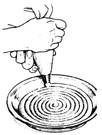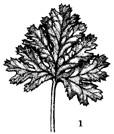Read Pie and Pastry Bible Online
Authors: Rose Levy Beranbaum
Pie and Pastry Bible (172 page)
Tube
A star tube.
Position of Bag
45- to 90-degree angle with end of bag at 6:00, tube slightly above surface. (I prefer the flatter, wider shell you get from the higher angle.)
Method
Squeeze firmly, allowing the icing to fan out as for a regular shell. Then move the tube to the left, up and around, in a question-mark shape. (Figures 06 and 7). Gradually relax the pressure as you pull the tube down to the center, forming a straight tail. Continue as above.
MERINGUE SPIRAL DISCS
Tube
A number 6 large plain round pastry tube (½ inch in diameter).

Hold the bag in a vertical position (straight up and down) with the tube at least ½ inches above the pan. To achieve full height and a rounded shape, the batter must
be allowed to fall from the tube, not be pressed against the pan. Start in the center, moving the tip with your entire arm in smooth circles. To prevent gaps, allow the spirals of batter to fall against the side of—almost on top of—previous spirals. The weight of the mixture will cause them to fall exactly in place. To correct errors, use a small clean artist’s brush dipped in water.
CRYSTALLIZED FLOWERS AND LEAVES
Small edible flowers (see page 634), such as roses, lilacs, and wild violets (
not
African), and leaves such as the rose geranium (Figure 01) and mint, can be made into beautifully shimmering decorations to garnish pies or tarts. When you make them yourself, each petal remains separate and sparkling. Firm-petaled flowers such as roses are the easiest to work with. Sugared rose petals of varying hues are stunning scattered around the base of a serving plate. All that’s needed is a little egg white, superfine sugar, and petal dust or powdered food color and a small unused artist’s brush. Petal dust, available from cake decorating supply stores such as the New York Cake and Decorating Distributors (see page 677), comes in many subtle hues. Paste food color also works well. Wilton, for example, makes a grape paste color the perfect hue for lilacs and a violet paste color the perfect hue for violets. For red roses, it’s exciting to use powdered or paste red food color, as it intensifies and preserves the flower’s natural color. Most flowers will last for years after drying, with the exception of lilacs, which tend to brown around the edges after a few months.

CRYSTALLIZE THE FLOWERS AND LEAVES
Place the sugar in a small bowl and stir in the food color, starting with a small amount.
Place the egg white in another small bowl and beat it lightly.
If using roses, peel off any outer petals that are not in perfect shape. If the roses are too tightly closed, tease open the petals by blowing on them and probing them gently with the blunt end of a wooden skewer.
Dip the flowers facedown into the egg white. Use the artist’s brush to remove all but a thin coating, making sure that the underside of the petals is coated too. Hold the flower over the sugar bowl and with a small spoon, spoon the sugar over the flower’s petals to coat it evenly on both sides.
DRY THE CRYSTALLIZED FLOWERS AND LEAVES
Large multipetaled flowers such as roses can take up to 4 days to dry, while mint leaves can dry in just a few hours. Most flowers with softer petals, such as violets,
keep their shape best when suspended upside down until partially dry and set. This works well for rose geranium leaves too. Use a clamp type of paper clip to grasp each stem and hang it by the looped end. When partially dry, transfer it to a lightly greased rack to dry completely.
For roses, the method that works best is to cover a bowl tightly with a piece of foil, preferably heavy-duty, and punch small holes in the foil to hold the flowers upright. When the petals are dry enough to hold their shape on their own, transfer them to lightly greased racks to dry completely. Cut off all but about 2 inches of each stem, which can be used to insert the flower into the pie.
STORE
Airtight, at room temperature (low humidity), away from direct sunlight.
POINTERS FOR SUCCESS
 Superfine sugar (available in 1-pound boxes in supermarkets), also referred to as bar sugar, coats the most evenly. Processing granulated sugar dulls the sugar crystals, resulting in less sparkle.
Superfine sugar (available in 1-pound boxes in supermarkets), also referred to as bar sugar, coats the most evenly. Processing granulated sugar dulls the sugar crystals, resulting in less sparkle.
 If you’ve added too much food color, simply add more sugar to tone it down.
If you’ve added too much food color, simply add more sugar to tone it down.
 It’s best to sprinkle the sugar on the flowers or leaves, as dipping them into the sugar might cause it to clump both in the sugar bowl and on the flowers.
It’s best to sprinkle the sugar on the flowers or leaves, as dipping them into the sugar might cause it to clump both in the sugar bowl and on the flowers.
MEASURING DRY INGREDIENTS
Dry ingredients, such as flour, sugar, baking powder, baking soda, cornstarch, and salt, should be measured in solid measuring cups, i.e., ones with level unbroken rims (see page 658). As flour tends to settle on sitting, it should be stirred very lightly with a whisk or fork before measuring. The dip and sweep method means to dip the cup or measuring spoon into the dry ingredient and, without disturbing it (NO shaking or tapping, or you’ll get more than desired), sweep off the excess with a metal spatula or knife.
MEASURING LIQUID INGREDIENTS
Liquid ingredients, such as water, milk, sour cream, corn syrup, and juices, should be measured in a liquid measure, i.e., one with a spout. To get an accurate measure, set the cup on a solid surface (NOT in your hand, as it is easy to tilt) at eye level. The reading should be taken from below the meniscus (the slightly curved surface of the water).
*
There are some special pans, such as the Scanpan, from Denmark (see page 667), with nonstick properties that can withstand the heat of caramel.
*
Heat until small bubbles form around the perimeter.
*
Heat until small bubbles form around the perimeter.
Heat until small bubbles form around the perimeter.
INGREDIENTS
S
ugar, flour, butter, nuts, vanilla—these are the kingpins of pastry making. From these few ingredients come a world of delights, so it is important that each be of the best possible quality and the variety suited to the recipe. These days, it is easy in the supermarket, when reaching for sour cream or cream cheese, to inadvertently pick up one of the prevalent reduced-fat or fat-free versions. I find these substitutes odious, with synthetic flavor. My philosophy is to reduce portion size, or quantity—not the quality.
I have listed a few specific products because of their incomparable quality, available only through food service distributors, most of which can be purchased in reasonably small quantities.
BAKER’S JOY
This is a combination of flour and oil for spraying on pans. It is faster and neater than greasing and flouring. If you can’t find it in your local supermarket, get in touch with the manufacturer (see Sources) for the nearest distributor. This is a fabulous product.
BAKING POWDER
Baking powders are mixtures of dry acid or acid salts and baking soda with starch or flour added to standardize and help stabilize the mixture. “Double-acting” means that they will react, or liberate carbon dioxide, first when exposed to moisture during the mixing stage and then again when exposed to heat during the baking stage. It is, therefore, important to store baking powder in an airtight container to avoid humidity. There is also a substantial loss of strength in baking powder after 1 year. Date the bottom of the can when you buy it, or write an expiration date on the lid with a felt-tip marker. To test if it is still active, sprinkle a little over hot water. If it fizzes actively, it’s still okay.
I use Rumford baking powder, an all-phosphate product containing calcium acid phosphate. It lacks the bitter aftertaste associated with SAS baking powders, which also contain sodium aluminum sulfate. (The supposed advantage of SAS powders is that they release a little more carbon dioxide during the baking stage
than during the mixing stage, but I find I can interchange equal volume and weight of either type of baking powder.) Rumford baking powder is usually available in health food stores (probably because aluminum compounds are considered dangerous by many health-conscious people).
BAKING SODA
Sodium bicarbonate has an indefinite shelf life if not exposed to humidity. In Canada, I once discovered a wonderful variety called Cow Brand. It contained a harmless chemical ingredient that prevented it from clumping. Unless you can obtain this type of baking soda, it is best to sift it before measuring.
BEESWAX
Used for making spun sugar (page 602) because of its high melting point, beeswax helps keep the strands flexible. It is available at sculptors’ supply stores, some sewing supply stores, and, of course, through apiaries.
CHOCOLATE
Working with chocolate over the past twenty years, I have found there is an enormous difference in both texture and flavor among brands and have developed my own personal preferences. I highly recommend that you do a blind tasting to determine your own.

